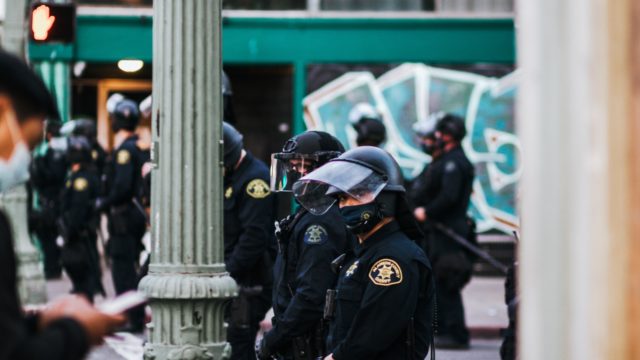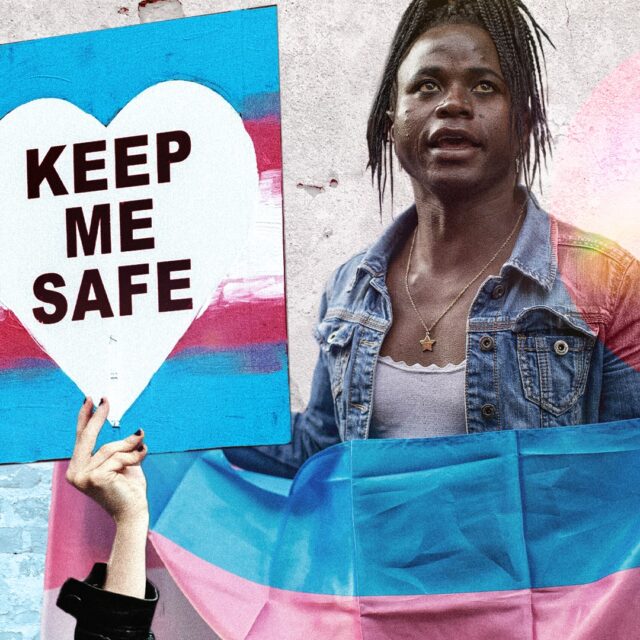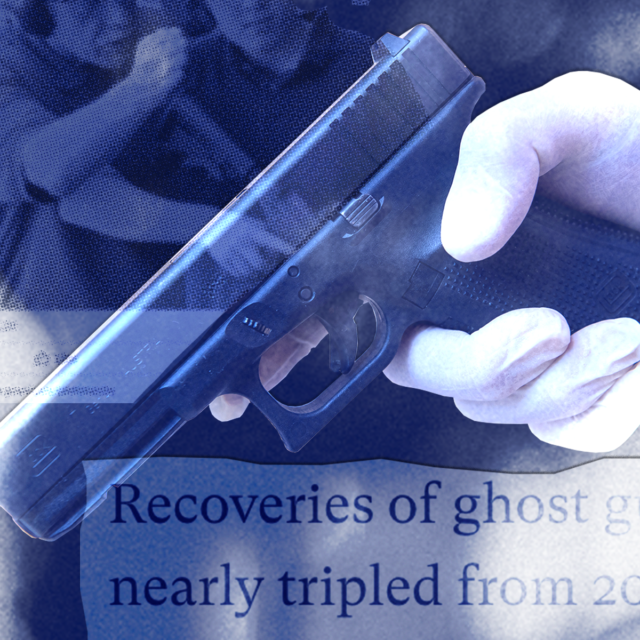Gun Violence and the Police
Last Updated: 5.10.2024

Summary
Gun violence is a uniquely American epidemic, and gun violence by police is, too. Every year, police in America shoot and kill nearly 1,100 people.1Everytown Research analysis of 2019 to 2023 Mapping Police Violence data (accessed February 21, 2024). The combination of systemic racism, white supremacy, America’s gun culture, and the militarization of police is toxic—and Black people in particular are paying with their lives.
Scope of Police Violence
In addition to the loss of life and the pain to family members and survivors, police shootings have a uniquely corrosive impact on the nation: patterns of police violence dramatically reduce public confidence in police and lead community members to see them as part of the problem.2Sixty percent of civilians (and 79 percent of Black civilians) perceive police killings of Black Americans as signs of a broader problem rather than isolated incidents. Rich Morin, Kim Parker, Renee Stepler, and Andrew Mercer, “Behind the Badge,” Pew Research Center, January 2017, https://assets.pewresearch.org/wp-content/uploads/sites/3/2017/01/06171402/Police-Report_FINAL_web.pdf. Similarly, following the police killings of Michael Brown, Eric Garner, and Walter Scott, and the related protests, public confidence in the police hit an all-time low of 52 percent. 2020 survey data is not yet available. Jeffrey M. Jones, “In U.S., Confidence in Police Lowest in 22 Years,” Gallup, June 19, 2015, https://news.gallup.com/poll/183704/confidence-police-lowest-years.aspx. The fear sown by these shootings makes neighborhoods less safe since law enforcement cannot do its part in preventing violent crime without the assistance of the community.
93 percent of deaths of civilians caused by police are with a firearm.
Last updated: 5.10.2024
As we have long heard from communities of color, police violence is gun violence. Indeed, 93 percent of deaths of civilians caused by police are with a firearm,3Everytown Research analysis of 2019 to 2023 Mapping Police Violence data (accessed February 21, 2024). and Black people are the victims at a disproportionate rate: they are nearly three times more likely to be shot and killed by police than white people.4Everytown Research analysis of 2019 to 2023 Mapping Police Violence (accessed February 21, 2024) and population data from the US Census. This may underestimate the true rate as race was unknown for approximately 10% of the reported deaths. National Violent Death Reporting System 2009-2012 (17 states participating) and also shows Black Americans killed by police at a rate 2.8 times higher than white Americans, see DeGue et al., 2016. CDC’s data on 2010-2014 deaths categorized as legal intervention shows a rate of police killing of Black males aged 10+ 2.8 times higher than white males 10+ years old, see Buehler, 2017.
3x
Black people are the victims at a disproportionate rate—they are nearly three times more likely to be shot and killed by police than white people.
Source: Everytown Research analysis of Mapping Police Violence data, 2019–2023 and US Census, “National Population by Characteristics, 2010–2019.”
To curb this gun violence and the disproportionate impact it has on Black and brown communities, it is essential that every law enforcement officer in America works for an agency with evidence-based policies—strong guardrails on when police may use force against civilians, ensuring police are held accountable when force is used, and prioritizing de-escalation, dignity, and respect. Any policing strategy must include at least these life-saving reforms:
Policy Pillar #1
A strong legal standard barring unnecessary police use of force and requiring officers to intervene and stop abuse.
Law enforcement must be barred from using deadly force except when absolutely necessary to prevent death or serious bodily harm, and only after exhausting other means. Lesser forms of force should be prohibited except when necessary to make an arrest.5A 2015 Bureau of Justice Statistics Police-Public Contact Survey estimates that 53.5 million U.S. residents 16 years or older (21 percent) had contact with the police in the past year. An estimated 2 percent of these individuals experienced nonfatal police force. This use-of-force rate was higher (3 percent) among Black Americans compared to white Americans (1 percent). Elizabeth Davis, Anthony Whyde, and Lynn Langton, “Contact between Police and the Public, 2015,” U.S. Department of Justice, Office of Justice Programs, Bureau of Justice Statistics, October 2018, https://www.bjs.gov/content/pub/pdf/cpp15.pdf. Every officer must be required to intervene when other officers use excessive force. Officers should generally be barred from shooting without proper officer identification, firing at moving vehicles, using warning shots, and using chokeholds and other neck restraints. Research suggests that implementing specific use-of-force policies can save lives. One 2016 study of 91 large police departments found adoption of use-of-force reform policies—exhaustion of other means prior to shooting, bans on chokeholds and strangleholds, use-of-force continuum, de-escalation, duty to intervene, restrictions on police shootings at moving vehicles, and warning before shooting—was associated with fewer people killed by police.6Samuel Sinyangwe, “Examining the Role of Use of Force Policies in Ending Police Violence,” September 20, 2016, https://static1.squarespace.com/static/56996151cbced68b170389f4/t/57e17531725e25ec2e648650/1474393399581/Use+of+Force+Study.pdf.
Policy Pillar #2
A commitment to de-escalation and building community relationships through procedural justice.
The best use-of-force policy reforms are those that reduce the perceived need to use force in the first place. When police engage in regular, meaningful community outreach and value efforts that support community trust, they become—in the words of the 21st Century Policing Task Force—“guardians” of the community and not “warriors” patrolling it. Specific instruction that assists in this transformation of mindset and practice includes de-escalation and procedural justice trainings. For example, a one-day procedural justice training in the Chicago Police Department reduced misconduct complaints by 10 percent and use of force by 6 percent over the following two years.7George Wood, Tom R. Tyler, and Andrew V. Papachristos, “Procedural Justice Training Reduces Police Use of Force and Complaints against Officers,” Proceedings of the National Academy of Sciences 117, no. 18 (May 2020): 9815–21, https://doi.org/10.1073/pnas.1920671117. Another study of mental health de-escalation training implemented in six jurisdictions found that it had significant impacts on the degree of force used by police as well.8Michael T. Compton et al., “The Police-Based Crisis Intervention Team (CIT) Model: II. Effects on Level of Force and Resolution, Referral, and Arrest,” Psychiatric Services 65, no. 4 (April 2014), https://doi.org/10.1176/appi.ps.201300108. Agencies should limit confrontations that can lead to excessive force, expanding alternative dispatch tools that include non—law enforcement personnel best positioned to help people in crisis connect with the social services they need.9President’s Obama’s Task Force on 21st Century Policing recommended multidisciplinary crisis teams. President Obama’s Task Force on 21st Century Policing, Final Report of the President’s Task Force on 21st Century Policing (Washington, DC: Office of Community Oriented Policing Services, 2015), Recommendation 4.3, https://bit.ly/3eTiMnL. Emerging evidence suggests that “co-response” models of policing can reduce detention, detainment, and use of force. Stephen Puntis et al., “A Systematic Review of Co-Responder Models of Police Mental Health ‘Street’ Triage,” BMC Psychiatry 18, no. 1 (2018): 256–67, https://doi.org/10.1186/s12888-018-1836-2; Etienne Blais et al., “Assessing the Capability of a Co-Responding Police-Mental Health Program to Connect Emotionally Disturbed People with Community Resources and Decrease Police Use-of-Force,” Journal of Experimental Criminology (2020): 1–25, https://doi.org/10.1007/s11292-020-09434-x.
“It is incumbent upon police chiefs and sheriffs to tackle this issue head on – by creating strong policies, providing excellent training and equipment, and making a concerted effort to change culture.”
Chuck Wexler, Executive Director, Police Executive Research Forum10Chuck Wexler, “Defender or Guardian? A Policing Dilemma,” The Crime Report, April 12, 2022, https://thecrimereport.org/2022/04/12/from-defender-to-guardian-a-policing-dilemma/
Policy Pillar #3
Deploy formal tools to identify officers who pose a risk of serious misconduct.
Departments should be required to use early intervention systems, which identify problematic officer behavior before it escalates into serious misconduct. A commitment to addressing early warning signs demonstrates a proactive approach that can help officers change (with counseling, retraining, reassignment, or intensive supervision) and keep faith with the community. Early identification systems, which have been supported by leading police research organizations,11See PERF [Police Executive Research Forum], “Supervision and Intervention within Early Intervention Systems: A Guide for Law Enforcement Chief Executives,” December 2005, https://bit.ly/308bVCu. See also IACP, “Early Identification Systems,” May 2020, https://www.theiacp.org/sites/default/files/2020-05/EarlyIdentificationSystems%2005-19-2020-to%20publish.pdf. See also Police Foundation, “Best Practices in Early Intervention System Implementation and Use in Law Enforcement Agencies,” March 2019, https://bit.ly/2Y12Vg2. have been credited with declines in reported uses of force and police complaints.12A program in Miami–Dade County led to a 12-fold increase in the number of officers with zero use-of-force complaints. Samuel Walker, Geoffrey P. Alpert, and Dennis J. Kenney, “Early Warning Systems, Responding to the Problem Police Officer,” National Institute of Justice, July 2001, https://bit.ly/2Msur0s. On the state level, officials should consider setting minimum conduct standards with revocable officer licensing and engaging in regular review of agencies with abusive records.
Policy Pillar #4
A thorough and independent system for reviewing shootings and other use-of-force incidents.
Police misconduct must be subject to a clear and consistent scale for discipline. The civilian complaint process must be user-friendly, and police shootings and use-of-force complaints should be reviewed by internal police units that complete their work quickly and are transparent with the public about their findings.13New York and Los Angeles, for example, have a consistent process to investigate all firearm discharges, and the internal review divisions report directly to senior executive staff. See New York City Police Department, “Use of Force Report, 2018,” https://on.nyc.gov/2UqW4eP; Los Angeles Police Department, “Use of Force Review Division,” https://bit.ly/2BVuujt. Misconduct should also be subject to review by external civilian boards with independent authority to investigate complaints and make findings, ideally empowered to issue subpoenas and make binding recommendations.14While research in this area is still developing, one study of eight medium- to large-size cities found that police misconduct complaints are sustained more often when the results of internal affairs investigations are reviewed by civilian oversight boards. William Terrill and Jason R. Ingram, “Citizen Complaints against the Police: An Eight-City Examination Article,” Police Quarterly (October 2015), https://doi.org/10.1177/1098611115613320.
Potentially criminal use of force also requires thorough, independent investigation and prosecution. Too often, local district attorneys have a real or perceived conflict of interest when deciding whether or how to charge police officers with crimes. Indeed, in 98 percent of fatal shootings by police from 2019 to 2023 the officer was not charged with a crime.15Everytown analysis of 2019-2023 Mapping Police Violence data (accessed February 21, 2024), based on Fatal Encounters media tracking, LexisNexis searches, public records requests, and crowdsourced updates. This may underestimate the number of officers charged or convicted if the shooting was not reported in the media or happened years after the killing and therefore was reported as unknown or pending investigation in the dataset. Of the 6,394 people shot and killed by police, Mapping Police Violence identified 83 who had been charged, of which 14 were convicted of a crime. A 2017 analysis, by Michael Harriot published in The Root, found that officers served time in prison for killing Black civilians in only three cases between 2007 and 2017. As an alternative, accountability requires the regular appointment of independent prosecutors, including in cases when a civilian is shot or there is a legacy of misconduct by local officials.
Finally, police officers who use excessive force should not be shielded from civil liability by “qualified immunity,” a judicial doctrine that makes it nearly impossible for civilians who are hurt or killed to obtain monetary damages after a constitutional violation has occurred.
Policy Pillar #5
Transparency about use of force, policies, and procedures.
The existing data on police use of force are entirely insufficient, making it difficult for researchers to analyze excessive force and for policymakers to effectively evaluate the need for change.16The majority of fatal police shootings were officially misclassified as not law enforcement-related as recently as 2015. Justin Feldman, Sofia Gruskin et al., “Quantifying Underreporting of Law-Enforcement Related Deaths in the United States, Vital Statistics and News-Media-Based Data Sources: A Capture-Recapture Analysis,” PLoS Med 14 (2017), https://journals.plos.org/plosmedicine/article?id=10.1371/journal.pmed.1002399. Agencies should be required to publish regular reports about officer use-of-force and misconduct investigations,17Notably, the two most populous states—California and Texas—both require local agencies to report substantial use-of-force data. Cities like Minneapolis and Dallas have public dashboards with officer shootings data. including victim race, and should not be permitted to shield disciplinary records from public disclosure. Law enforcement groups like the Major Cities Chiefs Association and PERF (Police Executive Research Forum) have encouraged departments to record their data and submit it to the FBI,18Federal Bureau of Investigation, “National Use-of-Force Data Collection,” https://www.fbi.gov/services/cjis/ucr/use-of-force (accessed June 15, 2020). whose director called the lack of data “embarrassing and ridiculous.”19U.S. Commission on Civil Rights, “Police Use of Force: An Examination of Modern Policing Practices,” November 2018, https://www.usccr.gov/pubs/2018/11-15-Police-Force.pdf. Officers should be required to report shootings and other use-of-force incidents thoroughly and immediately, and agencies should report comprehensive use-of-force data publicly and to the national FBI data collection program. And to improve transparency into the circumstances leading to the use of force, reduce use-of-force incidents, and lower civilian complaints, officers in the field must be required to use activated body-worn and vehicle-mounted cameras.20A growing collection of research largely demonstrates that body-worn cameras are effective in strengthening community perceptions of the police and reducing use-of-force incidents and complaints–especially if there is clear policy stating when cameras must be turned on. Cynthia Lum et al., “Research on Body-Worn Cameras: What We Know, What We Need to Know,” Criminology and Public Policy 18, no. 1 (February 2019): 93–118, https://doi.org/10.1111/1745-9133.12412; Barak Ariel et al., “Report: Increases in Police Use of Force in the Presence of Body-Worn Cameras Are Driven by Officer Discretion: A Protocol-Based Subgroup Analysis of Ten Randomized Experiments,” Journal of Experimental Criminology 12 (2016): 453–63, https://doi.org/10.1007/s11292-016-9261-3. Similar trends have been upheld in multiple cities including Rialto, CA (see Barak Ariel, William A. Farrar, and Alex Sutherland, “The Effect of Police Body-Worn Cameras on Use of Force and Citizens’ Complaints against the Police: A Randomized Controlled Trial,” Journal of Quantitative Criminology 31 (2015): 509–35, https://doi.org/10.1007/s10940-014-9236-3); Las Vegas, NV (see Anthony Braga et al., “The Benefits of Body-Worn Cameras: New Findings from a Randomized Controlled Trial at the Las Vegas Metropolitan Police Department,” Final Report to the National Institute of Justice, 2013-IJ-CX-0016, September 2017); and Phoenix, AZ (see Charles M. Katz et al., “Evaluating the Impact of Officer-Worn Body Cameras in the Phoenix Police Department, Phoenix, AZ,” Center for Violence Prevention & Community Safety, Arizona State University, December 2014).
Conclusion
Solving the problem of police violence and its destructive impact on Black communities will take more than reforms aimed at reducing police shootings and holding officers accountable. It will also require the country to confront its history of racism and white supremacy and examine both the appropriate role of police in public safety and the scourge of gun violence in America. But the solutions outlined above would be meaningful steps that officials at every level of government and law enforcement can take. Police departments must work to reform both their policies and the mindset among their officers. Mayors and city councils must act where local agencies refuse to change. Governors and state legislatures should set statewide standards that restrict excessive force in all jurisdictions. The US Department of Justice must restart “pattern or practice” investigations of departments with an abusive history, which have led to critical reforms and 35 percent declines in officer shootings.21Departments saw reductions averaging 27 percent in the first year, and 35 percent in subsequent years. U.S. Commission on Civil Rights, “Police Use of Force: An Examination of Modern Policing Practices,” November 2018, https://bit.ly/2MvgWNq (pp. 88–89). Seven of the 10 departments with the biggest recent reduction in police shootings were subject to DOJ intervention. Vice News, “Shot by Cops and Forgotten,” December 2017, https://bit.ly/307pMcn. And Congress should write laws with a national impact, directly funding state and local interventions and withholding money from actors that do not implement minimum standards for policing and life-saving reforms.
Everytown Research & Policy is a program of Everytown for Gun Safety Support Fund, an independent, non-partisan organization dedicated to understanding and reducing gun violence. Everytown Research & Policy works to do so by conducting methodologically rigorous research, supporting evidence-based policies, and communicating this knowledge to the American public.




